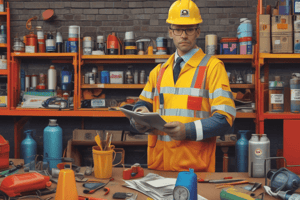Podcast
Questions and Answers
What are some of the risks associated with mining?
What are some of the risks associated with mining?
- Human error and natural forces (correct)
- Supply chain disruptions and market fluctuations
- Technological advancements and automation
- Labor union disputes and government regulations
Why is safety control essential in mining?
Why is safety control essential in mining?
- To increase productivity and efficiency
- To mitigate disaster in extremely dangerous conditions (correct)
- To reduce environmental impact
- To comply with international trade regulations
What are miners required to operate in underground mining?
What are miners required to operate in underground mining?
- Advanced robotics and AI systems
- Heavy machinery and explosives (correct)
- High-precision drilling equipment
- Chemical processing plants
What is the primary focus of safety and health awareness in mining?
What is the primary focus of safety and health awareness in mining?
Why is it important to predict natural forces in mining?
Why is it important to predict natural forces in mining?
Who does the Federal Mine Safety and Health Act of 1977 (Mine Act) cover?
Who does the Federal Mine Safety and Health Act of 1977 (Mine Act) cover?
How frequently does the Mine Act require MSHA to inspect each surface mine?
How frequently does the Mine Act require MSHA to inspect each surface mine?
Who is considered a 'miner' under the Mine Act?
Who is considered a 'miner' under the Mine Act?
What is the minimum number of times MSHA is required to inspect each underground mine?
What is the minimum number of times MSHA is required to inspect each underground mine?
Who is considered a 'mine operator' under the Mine Act?
Who is considered a 'mine operator' under the Mine Act?
Flashcards
Safety Control in Mining
Safety Control in Mining
The practice of implementing measures to prevent accidents and ensure the well-being of miners in mining operations.
Mining Risks
Mining Risks
The potential dangers faced in mining operations, such as ground collapses, explosions, and harmful gas exposure.
Regulatory Compliance in Mining
Regulatory Compliance in Mining
The formal and legal requirement for mining operations to follow specific safety standards and regulations.
PPE in Underground Mining
PPE in Underground Mining
Signup and view all the flashcards
Predicting Natural Forces in Mining
Predicting Natural Forces in Mining
Signup and view all the flashcards
Federal Mine Safety and Health Act of 1977
Federal Mine Safety and Health Act of 1977
Signup and view all the flashcards
MSHA Inspections of Surface Mines
MSHA Inspections of Surface Mines
Signup and view all the flashcards
Miner under the Mine Act
Miner under the Mine Act
Signup and view all the flashcards
Mine Operator under the Mine Act
Mine Operator under the Mine Act
Signup and view all the flashcards
MSHA Inspections of Underground Mines
MSHA Inspections of Underground Mines
Signup and view all the flashcards
Study Notes
Risks Associated with Mining
- Mining operations face hazards such as ground collapses, explosions, and exposure to harmful gases.
- Heavy machinery presents risks of accidents and injuries to workers.
- Environmental risks include land degradation, water contamination, and habitat destruction.
Importance of Safety Control in Mining
- Safety control is crucial to protect miners from hazards and ensure occupational health.
- Effective safety measures minimize the likelihood of accidents or injuries.
- Regulatory compliance and regular safety training foster a culture of safety and awareness among workers.
Requirements for Underground Mining Operations
- Miners must possess proper training and certifications relevant to underground operations.
- Personal protective equipment (PPE) is mandatory, including helmets, respirators, and safety boots.
- Emergency preparedness plans are required to address potential incidents.
Focus of Safety and Health Awareness in Mining
- Primary focus is on preventing workplace injuries and illnesses through education and training.
- Awareness programs emphasize the identification of hazards and risk management strategies.
- Continuous improvement of safety practices is critical to maintaining a safe working environment.
Importance of Predicting Natural Forces in Mining
- Predicting natural forces such as rock falls and seismic activities is essential to prevent accidents.
- Understanding geological conditions helps mitigate risks and protect workers.
- Precise prediction can lead to timely evacuations and emergency responses, enhancing overall safety.
Coverage of the Federal Mine Safety and Health Act of 1977
- The Mine Act protects all miners working in coal and non-coal mines.
- It also includes provisions for contractors and subcontractors on mining sites.
- The Act aims to enforce health and safety regulations and minimize risks associated with mining.
Inspection Frequency of Surface Mines under the Mine Act
- The Mine Act mandates that the Mine Safety and Health Administration (MSHA) inspects each surface mine at least once a year.
- This regular inspection ensures compliance with safety regulations and identifies potential hazards.
Definition of 'Miner' under the Mine Act
- A 'miner' refers to anyone who is employed by a mine operator for work at a mine site.
- This includes workers involved in extraction, processing, and equipment maintenance.
Inspection Requirement for Underground Mines by MSHA
- MSHA is required to inspect each underground mine at least four times a year.
- Increased frequency ensures thorough oversight of safety conditions in less accessible areas.
Definition of 'Mine Operator' under the Mine Act
- A 'mine operator' encompasses any individual or entity with legal control over a mining operation.
- This includes the responsibility for compliance with safety regulations and workers' health standards.
Studying That Suits You
Use AI to generate personalized quizzes and flashcards to suit your learning preferences.



